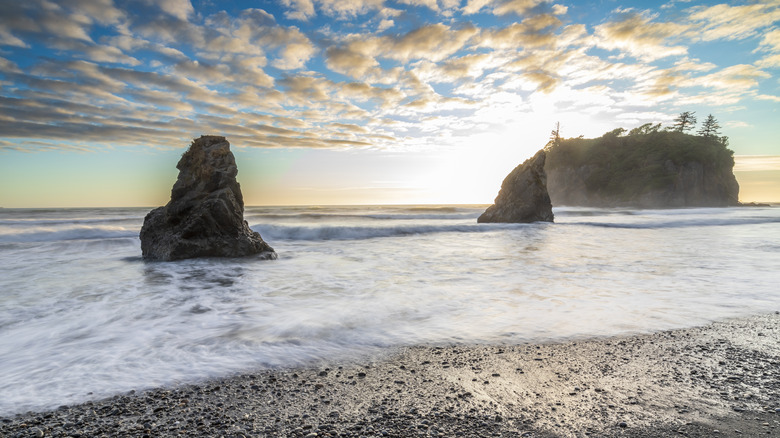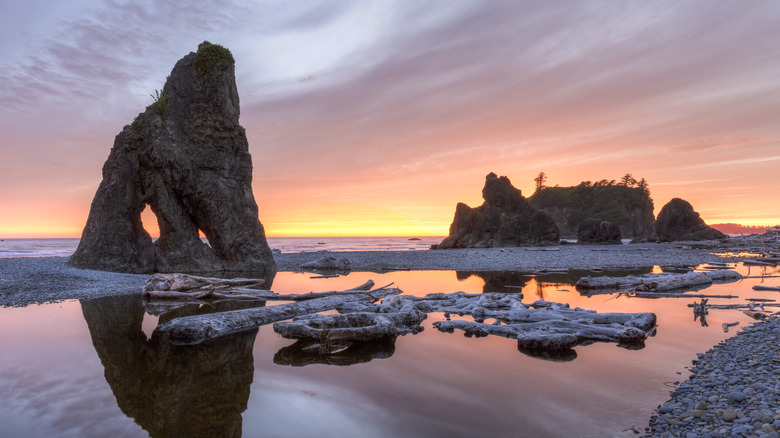One Of America's Best Beaches Is A Washington Paradise With Unique Landscapes And Iconic Rock Formations
Washington State doesn't leap to the front of many travel itineraries. But the Evergreen State has plenty to see, from an idyllic island getaway full of parks, beaches, and seafood to a sleepy escape with sweeping island views in Hansville. Ruby Beach deserves a mention, too, offering a "Best Of" version of Washington's charm. Its unique landscapes and iconic rock formations help it earn a spot in many "Best Beaches" conversations. Ruby Beach's wild beauty stands apart from the long list of well-manicured shoreline paradises dotting the planet. Forget the long stretches of milky white sand, turquoise waters, and gently lapping waves.
Swap all of that for large rock formations jutting out of random locations. No light stroll on the edge, where the water laps land. Instead, prepare for a hike interrupted by tree-sized driftwood, imposing sea stacks, and detritus of all kinds littering the ground. The unique combination truly shines when the setting sun casts an amber hue over everything, making it a paradise for photographers. Taken together, Ruby Beach's dramatic natural chaos creates one of the more beautiful slices of shoreline in America. The seemingly wild surroundings camouflage Ruby Beach's relative proximity to civilization.
Sea-Tac International Airport is the closest major travel hub, about three hours away by car. Travellers in Seattle can get to Ruby Beach via a three-and-a-half-hour drive. Just be warned: Parking is often tight. Plan your visit between June and September, if you can, when ideal weather and temperatures reign. Then, pack to match the forecast and throw in a poncho, given the Pacific Northwest's penchant for cranky weather. You'll also want to keep your robust footwear handy to help traverse the beach's rugged terrain. You can find accommodations at nearby Kalaloch's hotels and motels, often costing between $200 and $400 per night. Kalaloch also has 175 campsites open year-round.
Look up and down to see Ruby Beach's stunning views
Ruby Beach inherited its name from its almandite garnets — red minerals that drifted downriver from the Olympic Mountains, centuries of consistent pressure creating a fine crimson addition to the sand. This unique mix of sediments, combined with other charming debris, makes it a beachcomber's paradise. You can also catch a diverse mix of marine life stranded by the tides, as lower waters leave tidepools full of anemones and starfish scattered along the beach. The menagerie under your feet will draw your eyes down, looking for treasures of all stripes. But don't spend your entire visit looking at the sand.
The sea stacks jutting out of the beach like silent sentinels stand imposing, demanding your attention, lest you literally walk face-first into them while collecting shells. Abbey Island, a few hundred feet off shore, is Ruby Beach's most-recognizable formation. The jagged landscape, a mix of volcanic rocks and debris, is a remnant of a bygone coast, polished away by centuries of relentless, crashing waves. Those same rough seas give an ambiance that's unmatched, with the regular hum of the waves providing white noise that'll sooth even the most jangled of nerves. You may occasionally encounter unique driftwood shelters, built by visitors with a bit of extra time and inspiration.
Ruby Beach's appeal goes beyond its views, though. The rough landscape makes any stroll along the shore more like a hike. The Kalaloch area, which includes Ruby Beach, also has a enough marine wildlife to keep any nature lover enthralled. Three wildlife refuges protect colonies of murres, puffins, and other birds scampering along the rocky coast. And after you've had your fill at Ruby Beach, head over to its closest competitor, Rialto Beach, a hidden paradise with serene coastal views.

